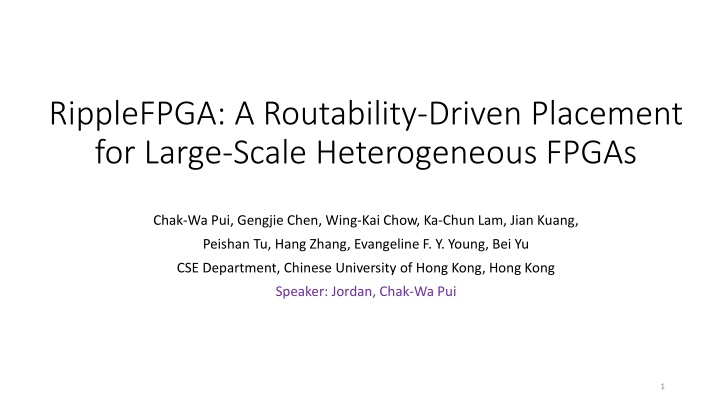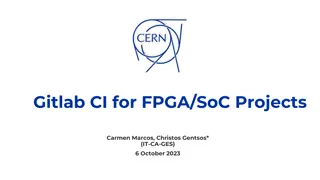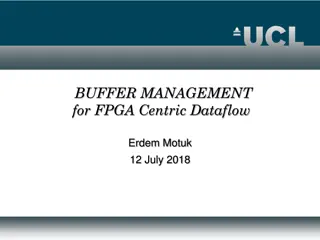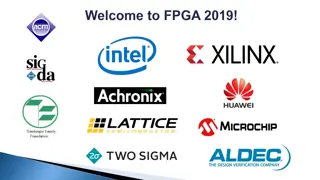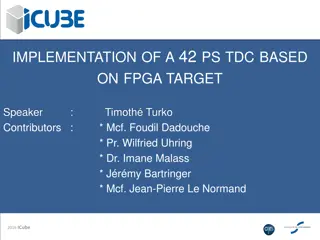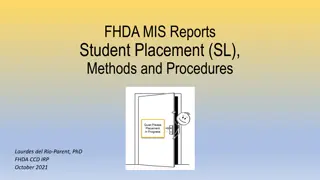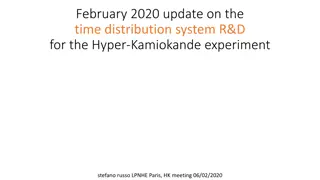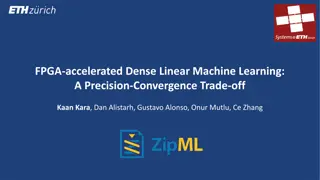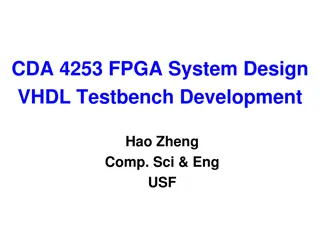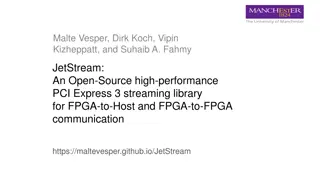Enhancing FPGA Placement: Routability Challenges and Solutions
This study delves into the complexities of FPGA placement in the realm of large-scale heterogeneous FPGAs. It addresses the growing concern of routability and introduces innovative placement techniques to mitigate routing congestion. The framework proposed in this research aims to optimize wirelength while adhering to architectural constraints and legal rules.
Download Presentation

Please find below an Image/Link to download the presentation.
The content on the website is provided AS IS for your information and personal use only. It may not be sold, licensed, or shared on other websites without obtaining consent from the author.If you encounter any issues during the download, it is possible that the publisher has removed the file from their server.
You are allowed to download the files provided on this website for personal or commercial use, subject to the condition that they are used lawfully. All files are the property of their respective owners.
The content on the website is provided AS IS for your information and personal use only. It may not be sold, licensed, or shared on other websites without obtaining consent from the author.
E N D
Presentation Transcript
RippleFPGA: A Routability-Driven Placement for Large-Scale Heterogeneous FPGAs Chak-Wa Pui, Gengjie Chen, Wing-Kai Chow, Ka-Chun Lam, Jian Kuang, Peishan Tu, Hang Zhang, Evangeline F. Y. Young, Bei Yu CSE Department, Chinese University of Hong Kong, Hong Kong Speaker: Jordan, Chak-Wa Pui 1
Outline Background Problem Formulation Algorithms Experimental Results 2
Introduction As the scale of FPGA grows rapidly, routability becomes a major problem in FPGA placement The complex architecture of heterogeneous FPGAs yields more sophisticated placement techniques Architecture sample of heterogeneous FPGA 3
Previous Works Three major categories Simulated annealing based, e.g. VPR Partitioning-based, e.g. [1] Analytical approach, e.g. [2][3] Limitations of previous works Very few of recent works considering routability Previous works mainly consider routability in packing Most of previous works on heterogeneous FPGAs pack logic elements into CLB and seldom change them after packing [1] Timing-driven partitioning-based placement for island style FPGAs. TCAD2006 [2] Analytical placement for heterogeneous FPGAs. FPL2012 [3] An efficient and effective analytical placer for FPGAs. DAC2013. 4
Contributions A framework for heterogeneous FPGA flat placement Several methods are proposed to reduce routing congestion Partitioning Multi-stage congestion-driven global placement Alignment-aware detailed placement 5
Problem Formulation Routability-driven FPGA placement Given the netlist and architecture of an FPGA Minimize: routed wirelength measured by VIVADO Subject to: each logic element has no overlap, no violation to the architecture specific legalization rules 6
Overview of Our Algorithm Partitioning Packing Routability-Driven Global Placement Legalization Routability-Driven Detailed Placement 7
Overview of Our Algorithm Partitioning Packing Routability-Driven Global Placement Legalization Routability-Driven Detailed Placement 8
Partitioning Motivation Unbalance between width and height of the chip Cannot be resolved by spreading but by reallocating (a)origin (b)spreading (c)reallocation Comparison of different methods in solving congestion 9
Partitioning Solution: Partition the circuit into sub-circuits using recursive bi-partitioning Cluster size less than 25% of #cells, cut size less than 5% of #net Reallocate the cells across the chip as sparse as we can Maintain relative order of clusters and cells inside the same cluster Give more space for the cells in spreading while not increase the HPWL too much cluster2 cluster1 10 (b)clustering (a)origin (c)reallocate
Partitioning Effect on real test case (a)w/o partitioning (b)with partitioning Comparison of spreading result w/o and with partitioning 11
Overview of Our Algorithm Partitioning Packing Routability-Driven Global Placement Legalization Routability-Driven Detailed Placement 12
Packing 1. Short global placement 2. Forming basic logic elements(BLEs) that consist of only one LUT and at least one FFs 3. Let the remaining LUTs and FFs be BLEs of itself only 4. Merging two BLEs into one if their LUTs have many connections LUT (a) (b) (f) (c) (d) (e) (g) FF BLE Different type of basic logic elements (BLEs) 13
Packing Use maximum weight matching in stage2, weight proportional to distance, only connected LUTs and FFs have edges In stage3, let the remaining LUTs and FFs be BLEs of itself only 1 3 1 9 2 5 2 4 6 3 4 7 6 5 10 9 7 8 10 0 11 0 11 8 Stage 2 How we do packing in stage2,3 14
Packing Use maximum weight matching in stage4, weight proportional to distance and connections between the LUTs of the vertices 1 4 1 3 1 5 2 2 4 2 4 6 8 3 7 3 8 9 7 0 0 10 0 5 7 6 5 11 8 Stage 3 6 How we do packing in stage4 15
Overview of Our Algorithm Partitioning Packing Routability-Driven Global Placement Legalization Routability-Driven Detailed Placement 16
Global Placement Quadratic placement based on Ripple Three-stage Optimization First two stages, optimize wirelength, fix DSP/RAM to their legal position after stage 1 Legalizing DSP/RAM disturbs the global placement result a lot Same displacement, difference in HPWL Large displacement The third stage optimize routability using inflation (Accumulative) 17
Global Placement Routing congestion estimation Probabilistic model Consider both bounding box and HPWl ?? ?????= 5 #G-Cell = 3 ?? ?????= 6 #G-Cell = 6 18
Routing congestion estimation (c)VIVADO (d)Ours (a)VIVADO (b)Ours Comparison of the routing congestion estimation obtained by VIVADO and us 19
Overview of Our Algorithm Partitioning Packing Routability-Driven Global Placement Legalization Routability-Driven Detailed Placement 20
Legalization Greedy window-based cell by cell legalization process Start from a small window Sites inside a window are consider to have same displacement Sort the sites by an objective function (HPWL) If cannot be legalized, slowly increase the window size until it s legalized Keep BLEs intact unless cannot be legalized 21
Overview of Our Algorithm Partitioning Packing Routability-Driven Global Placement Legalization Routability-Driven Detailed Placement 22
Detailed Placement Move to optimal region to optimize HPWL In both BLE level and CLB level In CLB level, if the site is occupied, swap the cells if the HPWL does not increase In BLE level, the BLE can only be moved to a slice if it won t violate legalization rules BLE BLE CLB 23
Detailed Placement If already in optimal region, move to site to optimize alignment(BLE level). Compute the score of each site by assuming the cell is moved to there and get the alignment score by considering all related nets Sort the candidate sites by their alignment score, try to move the cell to a site with smaller score (d) score=2 (e) score=1 (a)score=5 (b) score=4 (c) score=3 Comparison of alignment of different placement 24
Experimental Result Ours 1st Place 2nd Place 3rd Place Design Normalized WL Normalized WL Normalized WL Normalized WL WL Time(s) WL Time(s) WL Time(s) WL Time(s) FPGA-1 362563 74 1 - - - 379932 118 1.048 581975 97 1.605 FPGA-2 677563 167 1 677877 435 1.000 679878 208 1.003 1046859 191 1.545 FPGA-3 3617466 1037 1 3223042 1527 0.891 3660659 1159 1.012 5029157 862 1.390 FPGA-4 6037293 621 1 5628519 1257 0.932 6497023 1449 1.076 7247233 889 1.200 FPGA-5 10455204 1012 1 10264769 1266 0.982 - - - - - - FPGA-6 6960037 2772 1 6330179 2920 0.910 7008525 4166 1.007 6822707 8613 0.980 FPGA-7 10248020 2170 1 10236827 2703 0.999 10415871 4572 1.016 10973376 9196 1.071 FPGA-8 8874454 1426 1 8384338 2645 0.945 8986361 2942 1.013 12299898 2741 1.386 FPGA-9 12954350 2683 1 - - - 13908997 5833 1.074 - - - FPGA-10 8564363 5555 1 - - - - - - - - - FPGA-11 11226088 3636 1 11091383 3227 0.988 11713479 7331 1.043 - - - FPGA-12 8928528 9748 1 9021768 4539 1.010 - - - - - - Comparison of wirelength and runtime of our placer and the top3 winners 25
Experimental Result Raw With congestion-driven GP WL With partitioning WL With Both Design WL Normalized WL Normalized WL Normalized WL WL Normalized WL FPGA-1 362563 1.000 364143 1.004 378029 1.043 377883 1.042255 FPGA-2 681418 1.000 677563 0.994 696417 1.022 689360 1.011655 FPGA-3 4027586 1.000 3999517 0.993 3645846 0.905 3617466 0.898172 FPGA-4 6037293 1.000 6087199 1.008 6265158 1.038 6357766 1.053082 FPGA-5 - - - - - - 10455204 - FPGA-6 7801736 1.000 7723476 0.990 7016684 0.899 6960037 0.892114 FPGA-7 10248020 1.000 10615672 1.036 10338763 1.009 10580828 1.032475 FPGA-8 9171179 1.000 9392039 1.024 8874454 0.968 9013564 0.982814 FPGA-9 12954350 1.000 13437554 - - - 13834692 1.067957 FPGA-10 - - 10372369 - 8782789 - 8564363 - FPGA-11 - - - - 11226088 - 11688504 - FPGA-12 - - 10286583 - - - 8928528 - Comparison of wirelength of different method used in our placer 26
Thanks 27
